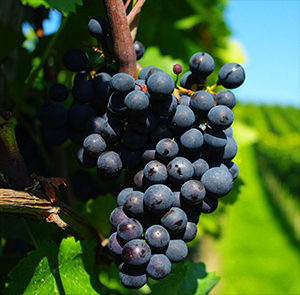This is not a post about a fiddle-playing Roman or the antics of two Italian cinema adventurers. Nero and Nerello are the names of two grapes responsible for some of Sicily's best red wines.
A closer look at the grapes full names - Nero d'Avola and Nerello Mascalese - gets us closer to why Sicilians like these two varieties for their red wine. Growers in southern Sicily prefer to keep things localized, such as using the name Calabrese when referring to Nero d'Avola.
Nero d'Avola
Nero d'Avola or "Black of Avola" is the most widely planted grape on the island, yielding deeply colored red wines with bright blackberry and cherry flavors, high tannins and medium acidity, just the wine to compliment the island's hearty cuisine.
The popular variety (and wine) gets its name from the town of Avola in the southern province of Siracusa. Avola is one of the main growing areas, along with Noto and Pachino.
Nero is commonly made as a varietal or used in blends, such as the noted Cerasuolo di Vittoria DOCG, a blend of Nero d'Avola and Frappato, a red grape probably related to Sangiovese.

There are numerous Nero d'Avolas in the market, widely priced from $12 for Tenuta Fenice, to $62 for Duca di Salaparuta. Others include Donnafugata $22, Feudo Montoni $55, Caruso Minini $19, Firriato $40, Stemmari $11, Cusumano $29, Tenuta Rapitala $14, Mazzei $20.
Nerello Mascalese
Nerello Mascalese and its cousin, Nerello Cappucio, are essential components in Faro DOC, a popular red wine from around Messina, in the far northeastern part of the island. The vineyards are on the Mascali plain, between Mt. Etna and the Mediterranean.
Nerello is a late-ripening variety, commonly trained on bush vines. Nerello Mascalese is more widely planted than Nerello Cappucio and is related to Sangiovese, producing red and rose wines that are deeply colored, with good texture, medium acidity and cherry flavors.

Nerello Mascalese is also a permitted grape in Calabria, across the narrow Messina Strait. The Calabrian wines are usually a blend of Mascalese and Cappucio. Blending of the two grapes is common in both Sicily and Calabria.
Sicilian red wines, and the occasional rose, are gaining attention. Here are ten Sicilian Nerello Mascalese wineries worth the search: Planeta, Gracia, Sciara, Donnafugata, Tasca d'Alamerita, Passopisciaro, Giovanni, Frank Cornelissen, Idda, Podere Giodo.
An aside. Over the years, I've collected a lot of wine books, old and relatively new. My small library includes a half-dozen books on Italian wine, the oldest is "The Wines of Italy," 1966, by the noted English writer, Cyril Ray, and the newest, "Vino Italiano," 2002, by Joseph Bastianich & David Lynch. Bastianich's mother is chef and restaurateur, Lidia Bastianich.
Despite the history of these two grapes in Sicily and their popularity, there is little mention of southeastern Sicilian wineries working with either of these grapes, in any of the four books.
Ray's book has a single entry about Nero, referring to the grape as "Negra" d'Avola. "Italian Wine," 1982, by Victor Hazan does not mention Nero d'Avola but notes briefly that Nerello Mascalese is a part of Faro. "Vino," 1980, by Burton Anderson, the book on Italian wine that American wine collectors know best, has numerous listings of Nero and both Mascalese and Cappuccio, but only as components of certain wines.
Lynch and Bastianich discuss Nerello Mascalese and give Nero d'Avola its due, probably because they talked to so many vintners who believe Nero is Sicily's grape of the present and future. Though, Diego Planeta doesn't agree, telling the authors, that, in his opinion, Syrah is Sicily's great red hope. "It's just like Nero d'Avola: it loves the heat."
Why have I gone on at length about the meager treatment of Nero and Nerello in older wine books? Researching, writing, editing and publishing a wine reference book takes a year, at least, making books outdated before they are released.
So, if you're looking for wine information, use reference books for the basics, but for current specifics, consult dedicated on-line providers like Wine-searcher, Wine Folly, The Gray Report, Wine Review Online, The WineKnowLog and, of course, Gerald D Boyd On Wine.
And while you're looking up information on Sicilian wines, have a glass of Nero d'Avola or Nerello Mascalese.
Next post: Spanish Whites
Leave a comment at boydvino707@gmail.com




